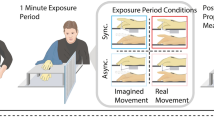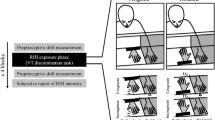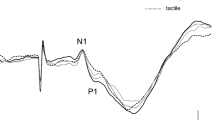Abstract
The body ownership induced by the rubber hand illusion (RHI) has been related to a neural network involving a frontal–parietal circuit. Previous functional neuroimaging studies have demonstrated neural activation in the parietal area relative to the multisensory integration processing and to the recalibration of the felt position of body while a ventral premotor cortex activation has been linked to bodily self-attribution during the RHI. Our study aimed to investigate the effects of transcranial direct current stimulation (tDCS) on the posterior parietal cortex (PPC) or on the premotor cortex (PMv) during RHI to address the specific roles of these two brain areas in the illusion. 156 young adult participants (21.2 ± 3.13 years old; all right-handed) were enrolled for this between-subjects design experiment. Participants received anodal, cathodal and sham tDCS in three different sessions on the right PPC or right PMv and experienced visual–tactile stimulation from the brushes touching the rubber hand and their own left hand in synchronous or asynchronous manner. The RHI was quantified by the (1) onset time for the feeling of body ownership of the rubber hand, (2) proprioceptive drift, and (3) questionnaire about the intensity of the illusion as reported by the participant. All subjects felt the RHI during the synchronous condition. However, we found that the illusion onset time can be modulated by the anodal tDCS condition on the PPC: anodal tDCS decreased the illusion onset time and the subjective experience of body ownership. These findings suggest that the parietal area plays a crucial role in the speed of visual and tactile multisensory integration in the RHI and introduce tDCS as technique that can accelerate the time to integrate an artificial body part and increased the perception of body ownership.


Similar content being viewed by others
References
Avenanti A, Annela L, Serino A (2012) Suppression of premotor cortex disrupts motor coding of peripersonal space. Neuroimage 63(1):281–288
Blakemore SJ, Bristow D, Bird G, Frith C, Ward J (2005) Somatosensory activations during the observation of touch and a case of vision–touch synaesthesia. Brain 128(7):1571–1583
Blanke O, Slater M, Serino A (2015) Behavioral, neural, and computational principles of bodily self-consciousness. Neuron 88(1):145–166
Boggio PS, Nunes A, Rigonatti SP, Nitsche MA, Pascual-Leone A, Fregni F (2007) Repeated sessions of noninvasive brain DC stimulation is associated with motor function improvement in stroke patients. Restorative Neurol Neurosci 25(2):123–129
Boggio PS, Rigonatti SP, Ribeiro RB, Myczkowski ML, Nitsche MA, Pascual-Leone A, Fregni F (2008) A randomized, double-blind clinical trial on the efficacy of cortical direct current stimulation for the treatment of major depression. Int J Neuropsychopharmacol 11(2):249–254
Bolognini N, Olgiati E, Rossetti A, Maravita A (2010) Enhancing multisensory spatial orienting by brain polarization of the parietal cortex. Eur J Neurosci 31(10):1800–1806
Bolognini N, Olgiati E, Maravita A, Ferraro F, Fregni F (2013) Motor and parietal cortex stimulation for phantom limb pain and sensations. PAIN 154(8):1274–1280
Boros K et al (2008) Premotor transcranial direct current stimulation (tDCS) affects primary motor excitability in humans. Eur J Neurosci 27(5):1292–1300
Botvinick M (2004) Probing the neural basis of body ownership. Science 305:5685, 782–783
Botvinick M, Cohen J (1998) Rubber hands ‘feel’ touch that eyes see. Nature 391(6669):756
Brozzoli C, Gentile G, Ehrsson HH (2012) That’s near my hand! Parietal and premotor coding of hand-centered space contributes to localization and self-attribution of the hand. J Neurosci 32(42):14573–14582
Caminiti R, Ferraina S, Johnson PB (1996) The sources of visual information to the primate frontal lobe: a novel role for the superior parietal lobule. Cereb Cortex 6(3):319–328
Collins KL, Guterstam A, Cronin J, Olson JD, Ehrsson H, Ojemann JG (2017) Ownership of an artificial limb induced by electrical brain stimulation. Proc Natl Acad Sci 114(1):166–171. https://doi.org/10.1073/pnas.1616305114
Costa TL, Lapenta OM, Boggio PS, Ventura DF (2015) Transcranial direct current stimulation as a tool in the study of sensory-perceptual processing. Atten Percept Psychophys 77(6):1813–1840
Datta A, Bansal V, Diaz J, Patel J, Reato D, Bikson M (2009) Gyri-precise head model of transcranial direct current stimulation: improved spatial focality using a ring electrode versus conventional rectangular pad. Brain Stimul 2(4):201–207
Dempsey-Jones H, Kritikos A (2014) Higher-order cognitive factors affect subjective but not proprioceptive aspects of self-representation in the rubber hand illusion. Conscious Cogn 26:74–89
Ehrsson HH, Spence C, Passingham RE (2004) That’s my hand! Activity in premotor cortex reflects feeling of ownership of a limb. Science 305(5685):875–877
Ehrsson HH, Holmes NP, Passingham RE (2005) Touching a rubber hand: feeling of body ownership is associated with activity in multisensory brain areas. J Neurosci 25(45):10564–10573
Ehrsson HH, Rosén B, Stockselius A, Ragnö C, Köhler P, Lundborg G (2008) Upper limb amputees can be induced to experience a rubber hand as their own. Brain 131(12):3443–3452
Gentile G, Petkova VI, Ehrsson HH (2011) Integration of visual and tactile signals from the hand in the human brain: an FMRI study. J Neurophysiol 105(2):910–922
Grivaz P, Blanke O, Serino A (2017) Common and distinct brain regions processing multisensory bodily signals for peripersonal space and body ownership. NeuroImage 147:602–618
Guterstam A, Petkova VI, Ehrsson HH (2011) The illusion of owning a third arm. PLoS One 6(2):e17208
Holmes NP, Spence C (2004) The body schema and multisensory representation (s) of peripersonal space. Cogn Process 5(2):94–105
Kammers MP, Verhagen L, Dijkerman HC, Hogendoorn H, De Vignemont F, Schutter DJ (2009) Is this hand for real? Attenuation of the rubber hand illusion by transcranial magnetic stimulation over the inferior parietal lobule. J Cogn Neurosci 21(7):1311–1320
Kilteni K, Maselli A, Kording KP, Slater M (2015) Over my fake body: body ownership illusions for studying the multisensory basis of own-body perception. Front Human Neurosci 9:141
Lee I, Chae Y (2016) Neural network underlying recovery from disowned bodily states induced by the rubber hand illusion. Neural Plast 2016:8307175. https://doi.org/10.1155/2016/8307175
Limanowski J, Blankenburg F (2015) Network activity underlying the illusory self-attribution of a dummy arm. Human Brain Mapp 36(6):2284–2304
Lira M, Dall’Agnol PA, Boggio SA, Boggio PS (2016) Ilusão da mão de borracha induzida por estímulos controlados por equipamento eletrônico. Psicol Teoria e Prática 18:1
Lira M, Egito JH, Dall’Agnol PA, Amodio DM, Gonçalves ÓF, Boggio PS (2017) The influence of skin colour on the experience of ownership in the rubber hand illusion. Sci Rep 7(1):15745
Lloyd D, Roberts N (2006) Role for human posterior parietal cortex in visual processing of aversive objects in peripersonal space. J Neurophysiol 95(1):205–214
Makin TR, Holmes NP, Ehrsson HH (2008) On the other hand: dummy hands and peripersonal space. Behav Brain Res 191(1):1–10
Maselli A, Slater M (2014) Sliding perspectives: dissociating ownership from self-location during full body illusions in virtual reality. Front Human Neurosci 8:693
Nitsche MA, Cohen LG, Wassermann EM, Priori A, Lang N, Antal A, … Pascual-Leone A (2008) Transcranial direct current stimulation: state of the art. Brain Stimul 1(3):206–223
Oldfield RC (1971) The assessment and analysis of handedness: the Edinburgh inventory. Neuropsychologia 9(1):97–113
Olivé I, Tempelmann C, Berthoz A, Heinze HJ (2015) Increased functional connectivity between superior colliculus and brain regions implicated in bodily self-consciousness during the rubber hand illusion. Human Brain Mapp 36(2):717–730
Pavlova E et al (2014) Transcranial direct current stimulation of the premotor cortex: effects on hand dexterity. Brain Res 1576:52–62
Petkova VI, Björnsdotter M, Gentile G, Jonsson T, Li TQ, Ehrsson HH (2011) From part-to whole-body ownership in the multisensory brain. Curr Biol 21(13):1118–1122
Rizzolatti G, Luppino G, Matelli M (1998) The organization of the cortical motor system: new concepts. Electroencephalogr Clin Neurophysiol 106(4):283–296
Rohde M, Di Luca M, Ernst MO (2011) The rubber hand illusion: feeling of ownership and proprioceptive drift do not go hand in hand. PLoS One 6:6, e21659
Serino A, Alsmith A, Costantini M, Mandrigin A, Tajadura-Jimenez A, Lopez C (2013) Bodily ownership and self-location: components of bodily self-consciousness. Conscious Cogn 22(4):1239–1252
Spence C, Pavani F, Maravita A, Holmes N (2004) Multisensory contributions to the 3-D representation of visuotactile peripersonal space in humans: evidence from the crossmodal congruency task. J Physiol Paris 98(1):171–189
Tsakiris M (2010) My body in the brain: a neurocognitive model of body-ownership. Neuropsychologia 48(3):703–712
Tsakiris M, Haggard P (2005) The rubber hand illusion revisited: visuotactile integration and self-attribution. J Exp Psychol Hum Percept Perform 31:1, 80
Tsakiris M, Prabhu G, Haggard P (2006) Having a body versus moving your body: how agency structures body-ownership. Conscious Cogn 15(2):423–432
Ventura de Oliveira JR, Romano-Silva MA, Ugrinowitsch H, Apolinário-Souza T, Fernandes LA, Parma JO, Lage GM (2018) Cathodal tDCS of the left posterior parietal cortex increases proprioceptive drift. J Motor Behavior. https://doi.org/10.1080/00222895.2018.1468311
Wawrzyniak M, Klingbeil J, Zeller D, Saur D, Classen J (2018) The neuronal network involved in self-attribution of an artificial hand: a lesion network-symptom-mapping study. Neuroimage 166:317–324
Wise SP, Boussaoud D, Johnson PB, Caminiti R (1997) Premotor and parietal cortex: corticocortical connectivity and combinatorial computations. Ann Rev Neurosci 20(1):25–42
Wold A, Limanowski J, Walter H, Blankenburg F (2014) Proprioceptive drift in the rubber hand illusion is intensified following 1 Hz TMS of the left EBA. Front Human Neurosci 8:390
Woods AJ, Antal A, Bikson M, Boggio PS, Brunoni AR, Celnik P, … Knotkova H (2016) A technical guide to tDCS, and related non-invasive brain stimulation tools. Clin Neurophysiol 127(2):1031–1048
Zeller D, Gross C, Bartsch A, Johansen-Berg H, Classen J (2011) Ventral premotor cortex may be required for dynamic changes in the feeling of limb ownership: a lesion study. J Neurosci 31(13):4852–4857
Zopf R, Savage G, Williams MA (2010) Crossmodal congruency measures of lateral distance effects on the rubber hand illusion. Neuropsychologia 48(3):713–725
Funding
M.L. was supported by a CAPES grant. P.S.B. is a CNPq research fellow (311641/2015-6). C.G. was supported by a FAPESP Grant (2017/19520-5). This project was supported by Fundo Mackenzie de Pesquisa.
Author information
Authors and Affiliations
Corresponding author
Rights and permissions
About this article
Cite this article
Lira, M., Pantaleão, F.N., de Souza Ramos, C.G. et al. Anodal transcranial direct current stimulation over the posterior parietal cortex reduces the onset time to the rubber hand illusion and increases the body ownership. Exp Brain Res 236, 2935–2943 (2018). https://doi.org/10.1007/s00221-018-5353-9
Received:
Accepted:
Published:
Issue Date:
DOI: https://doi.org/10.1007/s00221-018-5353-9




